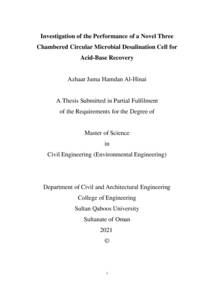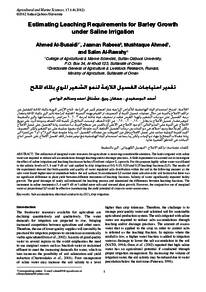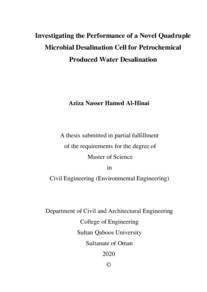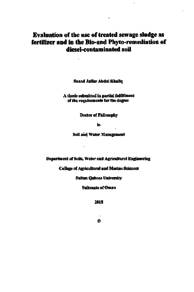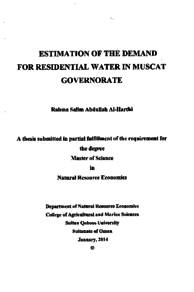Document
Investigation of the performance of a novel three chambered circular microbial desalination cell for acid-base recovery.
Publisher
Sultan Qaboos University.
Gregorian
2021
Language
English
English abstract
Microbial desalination cell (MDC) is considered as an eco-friendly technology for water
purification in which organic contaminants in wastewater are used as energy source to
drive the desalination process. Microbial desalination and chemicals production cell
(MDCC) is a novel device, modified version of MDC that desalinate saline water, produce
electricity, and concurrently produce acid and base. However, several factors have limited
the MDCCs performance and their development, such as, pH imbalance and ions
accumulation. In addition, adding chemicals production compartment and bipolar
membrane (BPM) may increase the internal resistance (Rint). This research demonstrated
the proof-of-concept for a three-chamber circular MDCC (TC-MDCC) with a new
arrangement of the anion, cation exchange and bipolar membranes. The novel design
aimed to investigate – (i) the cell performance in terms of acid-base production, salt
removal and current generation with/without external power supply utilizing two salt
concentrations (35 g/L NaCl and 10 g/L NaCl), (ii) the effect of bipolar membrane and
initial NaCl concentrations on the cell internal resistance, and (iii) compering the cell
performances with/without external power source.
Results showed that the current production was increased in the TC-MDCC from 1.94 mA
and to 3.3 mA, when the initial NaCl concentration was increased from 10 to 35 g/L,
because of the high conductivity of electrolyte. Thus, the internal resistance decreased from
300 to 270 Ω, which were much higher than Rint of MDC (85 Ω for 10 g/L salt, 75 Ω for
35 g/L salt). The pH of the electrolyte chamber of MDCC always remained constant, which
greatly enhanced the activity of the microorganism in the anode chamber. Desalinating 10
g/L salt without any external applied energy, the pH of the HCl production chamber
decreased to 3.029 and the pH of the alkali-production chamber increased to 8.96. The pH
changes were enhanced by using more concentrated salt (2.79 (acid) and 9.41 (base))
achieving a maximum desalination rate of 51%. With applied voltages of 0.3-1.0 V, 27-
57% desalination rate were achieved within 24 hrs using 35 g/L salt with simultaneous
production of HCl and NaOH with an optimum production rates of 1.96 mg/h of acid and
65.4 mg/h for the base applying external 1.0 V. These results demonstrated proof of
concept for producing acid and base using renewable source of energy, which could be
enhanced by integrating it with the MFC as a sustainable source of energy.
Member of
Resource URL
Arabic abstract
تعتبر خلية التحلية الميكروبية )MDC )تقنية صديقة للبيئة لتحلية للمياه حيث يتم استخدام امللوثات العضوية املتواجدة في مياه الصرف الصحي كمصدر للطاقة لتحفيز عملية تحلية للمياه. خليةالتحليةالميكروبيةوإنتاج الموادالكيميائية)MDCC )هي جهاز جديد تم تعديله من خلية ميكروبية عادية، يقوم بعدة مهام متزامنة وهي تحلية للمياه المالحة،معالجة للمياه العادمة، إنتاج الكهرباء،وإنتاج الأحماض والقواعد الكيميائية. ومع ذلك هناك العديد من العوامل التي تؤثر على أداء هذه الخليةوتطويرها، على سبيل املثال التغير في ً معدل الحموضة بسبب عدم توازن الرقم الهيدروجيني،وتراكم الأيونات على أسطح أغشية نقل الأيونات. ا أيض قد يؤدي إضافة غرفة (. أثبت هذا البحث قدرة هذه الخلية Rint إنتاج المواد الكيميائية وغشاء ثنائي القطب )BPM )إلى زيادة للمقاومة الداخلية بالجهاز ) الميكروبية الكهروكيميائية المبتكرة )MDCC-TC )ذات التصميم الدائري المصمم من ثلاث غرف على إنتاج مواد كيميائية بدون إستخدام أي مصدر خارجي للطاقة. حيث أنه يهدف إلى: 1 .دراسة قدرة الخلية على إنتاج المواد الكيميائيةبالتوليد الذاتي للتيار الكهربائي ، وأيضا باستخدام مصدر خارجي للطاقة بفحص تركيزين مختلفين من ملحكلوريد الصوديوم ) 35 جم / لتر و 10 جم / لتر(. 2 .دراسة تأثير الغشاء ثنائي القطب)BPM)وتركيز ملحكلوريد الصوديوم على للمقاومة الداخليةللخلية. 3 .مقارنة أداء الخلية املبتكرة بأداء خلية تحلية ميكروبية عادية لها نفس التصميم و ينعدم بها الغشاء الثنائي القطب و غرفة إنتاج المواد الكيميائية. أظهرت النتائج أنه عند فحص الخلية بدون استخدام أي مصدر خارجي للطاقة تلاحظ زيادة في توليد التيار الكهربائي من 94.1 مللي أمبير إلى 3.3 مللي أمبير عندما تمت زيادة تركيزأملاح)هيدروكسيد الصوديوم( المراد تحليته من 10 إلى 35 جم ملح/ لتر بسبب قدرة امللحذو التركيز العالي على توصيل التيار الكهربائي لقدرته العالية على التأين، وبالتالي انخفضت للمقاومة الداخلية من 300 إلى 270 أوم، وهي أعلى بكثيرمن مقاومة الخلية العادية) 85 أوم لتركيز 10 جم ملح/ لتر، 75 أوم لتركيز 35 جم ملح/ لتر(. أيضا تلاحظ ثبات في الرقم الهيدروجيني للخلية بغرفة معالجة للمياه و الذي بدوره ساهم بشكل كبير على تحفيز نشاط الكائنات الميكروبية في غرفة القطب السالب للخلية )الأنود(وقدرتها علىالتحليل البيولوجي. عند فحص أداءالخليةباستخدام محلول 10 جم ملح/لتر بدون استخدام أية مصدر خارجيللطاقةفقد تلاحظ انخفاضالرقم الهيدروجينيلغرفةإنتاج حمضالهيدروكلوريكإلى 029.3 وزادالرقم الهيدروجيني لغرفة إنتاج هيدروكسيد الصوديوم إلى 96.8 و الذييعتبرمؤشر لقدر ةالخلية على إنتاج الموادالكيميائية من أحماض وقواعد، بالمقابل تلاحظ تغير أكبر في الرقم ً عند فحص الخلية باستخدام المحلول الأقوى تركيزا الهيدروجيني والذي بلغ 79.2 في غرفة إنتاج الحمض و41.9 في غرفةإنتاج هيدروكسيد الصوديوم، حيثب لغ أعلى معدل كفاءة أداء الخلية لتحلية للمياه51.% عند فحص الخلية باستخدام مصدر خارجي للطاقة من 3.0 إلى 0.1 فولت، تم تحقيق معدل تحلية 27-57 %خالل 24 ساعة باستخدام 35 جم ملح/ لترمع الأنتاج المتزامن للحمض والقاعدةبأعلى معدلات إنتاج بلغت 35.1ملجم حمضالهيدروكلوريك/ساعة و 4.65 ملجم هيدروكسيد الصوديوم / ساعة باستخدام 0.1 فولت. ً وبالتالي على أظهرت هذه النتائج دليال قدرة هذه الخلية الميكروبية ثلاثية الغرف على إنتاج حمض الهيدروكلوريك وهيدروكسيد الصوديوم باستخدام مصدر طاقة متجدد و الذييمكن تعزيزه الحقامن خالل دمجه مع خلية وقود ميكروبية كمصدر مستدام للطاقة.
Category
Theses and Dissertations

